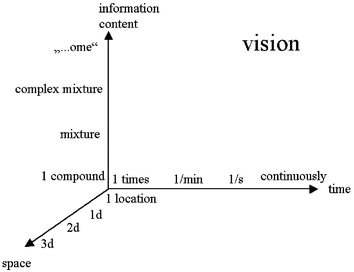Right into a “Bio” world
The information needs in analytical (bio)chemistry have never been so urgent as in the current functional genomics, proteomics, metabolomics, cell analysis and drug discovery areas. Already today, information densities of 100![[thin space (1/6-em)]](https://www.rsc.org/images/entities/char_2009.gif) 000-times of today’s analytical throughput are needed, at no extra cost. A simple scaling calculation predicts that high-throughput methods could improve the quality, speed and parallel processing of current methods to meet and support these requirements. However, dimensions will have to be within 1–100 microns for channel dimensions. Exactly the area Lab on a Chip is covering in terms of publications.
000-times of today’s analytical throughput are needed, at no extra cost. A simple scaling calculation predicts that high-throughput methods could improve the quality, speed and parallel processing of current methods to meet and support these requirements. However, dimensions will have to be within 1–100 microns for channel dimensions. Exactly the area Lab on a Chip is covering in terms of publications.The current world economic situation has effectively led to the closing of large areas of research. Companies focus on their core business and abandon new risky projects. Examples in analytical instrumentation have been Motorola (Arizona) and Corning (New Jersey) which have both stopped their biotechnology and microfluidics research in the last 2 years. Traditional instrument manufacturers are also generally more hesitant to spend money on research. Therefore, instrument companies are not sufficiently competitive or attractive to academic research at the moment. Very often, they are over-cautious not to enter developments which would be damaging to their own marketing plans, even though such developments would be of benefit to the end user. I see this as an opportunity for the expansion of academic and corporate research in the near future.
Analytical (bio)chemistry research is spread over a very large number of university institutes worldwide. There are less than a dozen such institutes with significant research activities, e.g., Iowa State University, Ames (Iowa), Barnett Institute, Boston (Massachusetts), Technical University Vienna (Austria). Many important universities decide to run very small research departments only, e.g., Stanford, Harvard, Yale, ETH Zürich, Oxford. However, most quantum leaps in chemistry and the life sciences have been made possible by corresponding developments in analytical instrumentation, e.g., electrophoresis, NMR, electrospray MS. This is also reflected in a number of Nobel prizes in medicine, chemistry and physics. Again, another opportunity for the Lab on a Chip journal.
The ultimate vision for analytical (bio)chemistry would be to identify and quantify all compounds in a mixture (genomics, proteomics, metabolomics), ... as a function of time (monitoring) and ... as a function of space (imaging). Most current analytical techniques would be in the 1 location, 1 time and 1 analyte corner (see figure). Some methods nicely demonstrate more sophistication in terms of information content (chromatography, XRF, ICP-MS, 2D electrophoresis), in terms of timescale (sensors) or in terms of imaging (PET scanning, tomography, fluorescence microscopy). This however, will make it essential to have very high resolution separations, if possible multi-dimensional, high resolution spectroscopic methods, high speed reaction mixing and proper data reduction to be available.
Lab on a Chip is poised to meet these opportunities and welcomes research addressing these important areas. The change of the subtitle to ‘Miniaturisation for Chemistry, Biology and Bioengineering’ exemplifies the multi-dimensionality and evolution of the journal to meet the changing demands of the scientific community in this fast-moving field of endeavour. It is hoped that this change will particularly encourage authors and research from the bioengineering sector and help make Lab on a Chip a more rounded, attractive and higher impact journal.
A large increase in 2003 submissions encouraged the move from four to six issues in 2004, submissions in 2004 continue to rise, thus it will be a challenge to maintain the high quality of published material, nonetheless, relevant papers, communications and reviews are all welcome and encouraged. The current Impact Factor for the journal stands at 3.63, thus the visibility of your work to the miniaturisation community is assured.
Finally, a word of thanks to all our reviewers, who helped to ensure that the material published in Lab on a Chip was of a sufficient calibre to warrant such a high First Impact Factor, and made sure that the journal got off to an excellent start. We are indebted to you for your assistance and guidance.
Andreas Manz
Editorial Board Chair
Harp Minhas
Managing Editor
| This journal is © The Royal Society of Chemistry 2004 |


